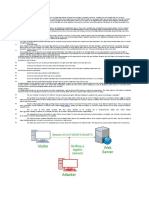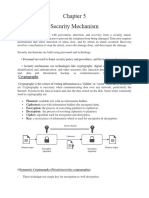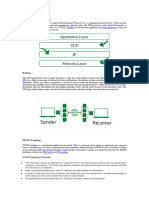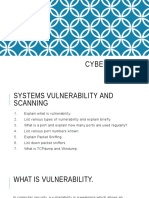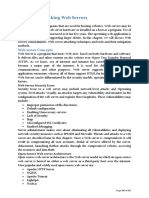Evading Firewalls: Firewall Identification
Evading Firewalls: Firewall Identification
Uploaded by
Karen GarzaCopyright:
Available Formats
Evading Firewalls: Firewall Identification
Evading Firewalls: Firewall Identification
Uploaded by
Karen GarzaOriginal Description:
Original Title
Copyright
Available Formats
Share this document
Did you find this document useful?
Is this content inappropriate?
Copyright:
Available Formats
Evading Firewalls: Firewall Identification
Evading Firewalls: Firewall Identification
Uploaded by
Karen GarzaCopyright:
Available Formats
Evading Firewalls
Firewall Identification
Identification of firewall includes firewall fingerprinting to obtain sensitive
information such as open ports, version information of services running in a network,
etc. This information is extracted by different techniques such as Port scanning, Fire-
walking, Banner grabbing, etc.
Port Scanning
Port Scanning is the examination procedure that is mostly used by the attackers to
identify the open port. However, it may also be used by the legitimate users. Port
scanning it does not always lead to an attack as it used by both of them. However, it is
a network reconnaissance that can be used before an attack to collect information. In
this scenario, special packets are forwarded to a particular host, whose response is
examined by the attacker to get information regarding open ports.
Fire-walking
Fire-walking is a technique in which an attacker, using ICMP packet find out the
location of firewall and network map by probing the ICMP echo request with TTL
values exceeding one by one. It helps the attacker to find out a number of hops.
Banner Grabbing
Banner grabbing is another technique in which information from a banner is grabbed.
Different devices such as routers, firewalls, and web server even display a banner in
the console after login through FTP, telnet. Vendor information for a target device and
firmware version information can be extracted using banner grabbing.
IP Address Spoofing
As defined earlier in the workbook, IP Address Spoofing is a technique, that is used to
gain unauthorized access to machines by spoofing IP address. An attacker illicitly
impersonates any user machine by sending manipulated IP packets with spoofed IP
address. Spoofing process involves modification of header with a spoofed source IP
address, a checksum, and the order values.
Source Routing
Source routing is a technique of sending the packet via selected route. In session
hijacking, this technique is used to attempt IP spoofing as a legitimate host with the
help of Source routing to direct the traffic through the path identical to the victim's
path.
By passing Techniques
Bypassing Blocked Sites Using IP Address
In this technique, Blocked Website in a network is accessed using IP address. Consider
a firewall blocking the incoming traffic destined to a particular domain. It can be
accessed by typing IP address in URL instead of entering domain name unless IP
address is also configured in access control list.
Page 381 of 503
Bypass Blocked Sites Using Proxy
Accessing the blocked websites using a proxy is very common. There are a lot of online
proxy solution available which hide your actual IP address to allow to access restricted
websites.
Bypassing through ICMP Tunneling Method
ICMP tunneling is a technique of injecting arbitrary data in the payload of echo packet
and forwarded to target host. ICMP tunneling functions on ICMP echo requests and
reply packets. Basically using this ICMP tunneling, TCP communication is tunneled
over ping request and replies because payload field of ICMP packets are not examined
by most of the firewalls, whereas some network administrators allow ICMP because of
troubleshooting purpose.
Bypassing Firewall through HTTP Tunneling Method
HTTP tunneling is another way to bypass firewalls. Consider a company with a web
server listening traffic on port 80 for HTTP traffic. HTTP tunneling allows the attacker
to despite the restriction imposed by the firewall by encapsulating the data in HTTP
traffic.
The firewall will allow the port 80; an attacker may perform the various task by hiding
into HTTP such as using FTP via HTTP protocol.
HTTP Tunneling Tools
HTTPort
HTTHost
Super Network Tunnel
HTTP-Tunnel
Bypassing through SSH Tunneling Method
OpenSSH is an encryption protocol that is basically used for securing the traffic from
different threats and attacks such as eavesdropping, hijacking, etc. SSH connection is
mostly used by applications to connect to the application servers. The attacker uses
OpenSSH to encrypt the traffic to avoid detection by security devices.
Bypassing Firewall through External Systems
Bypassing through the external system is a process of hijacking a session of a
legitimate user of a corporate network which is allowed to connect to an external
network. An attacker can easily sniff the traffic to extract the information, stealing
SessionID, cookies and impersonate him to bypass the firewall. An attacker can also
infect the external system used by the legitimate user with malware or Trojan to steal
information.
Page 382 of 503
You might also like
- Flávio Henrique Alves Syrio: Objective: It and New BusinessNo ratings yetFlávio Henrique Alves Syrio: Objective: It and New Business3 pages
- Why Do Hackers IP Spoof and How To Prevent ItNo ratings yetWhy Do Hackers IP Spoof and How To Prevent It7 pages
- Lectures 7 - To - 9 - Attacks Attackers Threat EnvironmentNo ratings yetLectures 7 - To - 9 - Attacks Attackers Threat Environment12 pages
- IP Spoofing: Nidhi Verma IT - 32 Northern India Engineering CollegeNo ratings yetIP Spoofing: Nidhi Verma IT - 32 Northern India Engineering College26 pages
- Group Members:-Imran Rashid Riya Kumari Nabanita Ghosh Samrat GhoshNo ratings yetGroup Members:-Imran Rashid Riya Kumari Nabanita Ghosh Samrat Ghosh22 pages
- Answers To Ethical Hacker Interview QuestionsNo ratings yetAnswers To Ethical Hacker Interview Questions5 pages
- Reconnaissance Scanning Gaining Access Maintaining Access Clearing TrackNo ratings yetReconnaissance Scanning Gaining Access Maintaining Access Clearing Track11 pages
- System Security Tool: Submitted By: Ravi Kumar Amitesh Kumar Vaibhav Gomber Amit GiriNo ratings yetSystem Security Tool: Submitted By: Ravi Kumar Amitesh Kumar Vaibhav Gomber Amit Giri17 pages
- Firewall: Role of Firewalls in Web SecurityNo ratings yetFirewall: Role of Firewalls in Web Security5 pages
- Cehv10 Module 01 Introduction To Ethical HackingNo ratings yetCehv10 Module 01 Introduction To Ethical Hacking219 pages
- An Integrated Approach To Detect and Limit IP Spoofing: International Journal of Computer Science and Mobile ComputingNo ratings yetAn Integrated Approach To Detect and Limit IP Spoofing: International Journal of Computer Science and Mobile Computing7 pages
- By Farha Ali, Lander University: IP SpoofingNo ratings yetBy Farha Ali, Lander University: IP Spoofing9 pages
- An Adaptive Log Based Realtime Network Scans in LANNo ratings yetAn Adaptive Log Based Realtime Network Scans in LAN6 pages
- WINSEM2022-23 CSE3502 ETH VL2022230503077 Reference Material I 18-01-2023 Lect 8No ratings yetWINSEM2022-23 CSE3502 ETH VL2022230503077 Reference Material I 18-01-2023 Lect 832 pages
- Software System Security Tool: Submitted byNo ratings yetSoftware System Security Tool: Submitted by17 pages
- Usiness Odule Security Technologies: Semester 2No ratings yetUsiness Odule Security Technologies: Semester 251 pages
- IP Spoofing Attack Detection Using Route Based Information: Sneha S. Rana, T. M. BansodNo ratings yetIP Spoofing Attack Detection Using Route Based Information: Sneha S. Rana, T. M. Bansod4 pages
- Firewalls and Network Security: Presented byNo ratings yetFirewalls and Network Security: Presented by12 pages
- Part A-Theoretical Questions: Cybersecurity100% (1)Part A-Theoretical Questions: Cybersecurity42 pages
- Wireless Network Security Issues and SolutionsNo ratings yetWireless Network Security Issues and Solutions18 pages
- MBSA Will First Get Updates From Microsoft, Scan, and Then Download The Security UpdatesNo ratings yetMBSA Will First Get Updates From Microsoft, Scan, and Then Download The Security Updates1 page
- Chapter 12: Evading IDS, Firewall and HoneypotsNo ratings yetChapter 12: Evading IDS, Firewall and Honeypots1 page
- Advantages Disadvantages: 3. Stateful Multilayer Inspection FirewallNo ratings yetAdvantages Disadvantages: 3. Stateful Multilayer Inspection Firewall2 pages
- Types of Honeypots 1. High-Interaction HoneypotsNo ratings yetTypes of Honeypots 1. High-Interaction Honeypots2 pages
- Back To Windows Server 2016 and Observe The LogsNo ratings yetBack To Windows Server 2016 and Observe The Logs1 page
- Go To Windows 7 Machine 5. Open Command Prompt 6. Generate Some Traffic Like FTPNo ratings yetGo To Windows 7 Machine 5. Open Command Prompt 6. Generate Some Traffic Like FTP1 page
- Fragmentation Attack: Denial-Of-Service Attack (Dos)No ratings yetFragmentation Attack: Denial-Of-Service Attack (Dos)2 pages
- Lab 13-1: Web Server Footprinting Using ToolNo ratings yetLab 13-1: Web Server Footprinting Using Tool1 page
- Evading Firewalls: Firewall IdentificationNo ratings yetEvading Firewalls: Firewall Identification2 pages
- Web Application Concepts: Server AdministratorNo ratings yetWeb Application Concepts: Server Administrator1 page
- Chapter 13: Hacking Web Servers: Technology BriefNo ratings yetChapter 13: Hacking Web Servers: Technology Brief1 page
- Web Server Misconfiguration: Figure 13-03 RobotsNo ratings yetWeb Server Misconfiguration: Figure 13-03 Robots1 page
- IIS Web Server Architecture: Components of IIS Protocol ListenerNo ratings yetIIS Web Server Architecture: Components of IIS Protocol Listener1 page
- Fragmentation Attack: Denial-Of-Service Attack (Dos)No ratings yetFragmentation Attack: Denial-Of-Service Attack (Dos)2 pages
- ARM Assembly Programming Using Raspberry Pi GUI PDFNo ratings yetARM Assembly Programming Using Raspberry Pi GUI PDF23 pages
- Lab 13-1: Web Server Footprinting Using ToolNo ratings yetLab 13-1: Web Server Footprinting Using Tool7 pages
- IBM DB2 and Canonical Ubuntu: Your Database Software and OS Platform Solution For Enterprise ComputingNo ratings yetIBM DB2 and Canonical Ubuntu: Your Database Software and OS Platform Solution For Enterprise Computing17 pages
- SPC For MS Excel V2.0 Demo InstructionsNo ratings yetSPC For MS Excel V2.0 Demo Instructions12 pages
- Ronggeng Di Nagari Ujung Gading Kecamatan Lembah Malintang Kabupaten Pasaman MailizarNo ratings yetRonggeng Di Nagari Ujung Gading Kecamatan Lembah Malintang Kabupaten Pasaman Mailizar6 pages
- Beginning SQL: Differences Between SQL Server and OracleNo ratings yetBeginning SQL: Differences Between SQL Server and Oracle32 pages
- Christa Moskal - 2 Assessments With TechNo ratings yetChrista Moskal - 2 Assessments With Tech4 pages
- Coolset™-F3: Off-Line Smps Current Mode Controller With Integrated 650V Startup Cell/Coolmos™No ratings yetCoolset™-F3: Off-Line Smps Current Mode Controller With Integrated 650V Startup Cell/Coolmos™30 pages
- 05 TM 1813 AVEVA Everything3D 1 1 Stairs Ladders and Handrail Modelling Rev 1 0 PDF100% (1)05 TM 1813 AVEVA Everything3D 1 1 Stairs Ladders and Handrail Modelling Rev 1 0 PDF82 pages
- 05 - HO - Logical Database Design and The Relational Model100% (1)05 - HO - Logical Database Design and The Relational Model14 pages
- Cross-Lingual Knowledge Graph Entity Alignment Based On Relation Awareness and Attribute InvolvementNo ratings yetCross-Lingual Knowledge Graph Entity Alignment Based On Relation Awareness and Attribute Involvement19 pages































